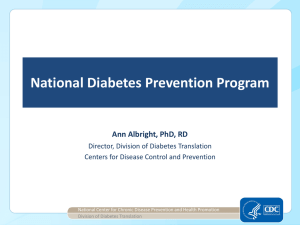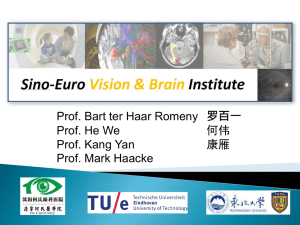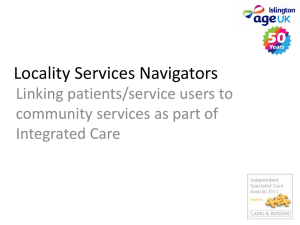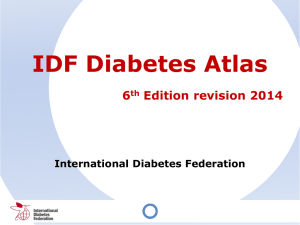Public Health * model for research (example
advertisement
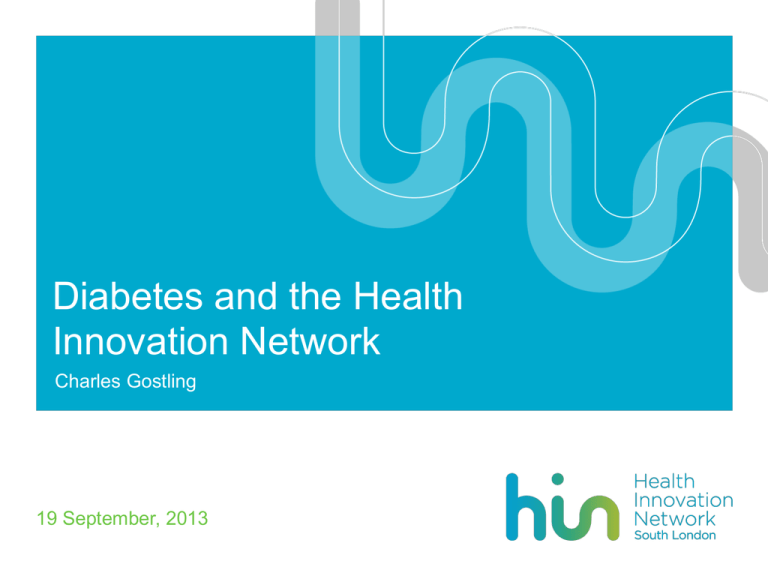
Diabetes and the Health Innovation Network Charles Gostling 19 September, 2013 Academic Health Science Network Aims As with the other 14 nationally designated AHSNs, the origins of the South London AHSN were in the Innovation Health and Wealth Report, published by the Department of Health in December 2011. The AHSN has 4 core objectives: 1.Focus on needs of patients and local populations 2.Build a culture of partnership and collaboration 3.Speed up adoption of innovation into practice, to improve clinical outcomes and patient experience 4.Create wealth through co-development, testing, evaluation and early adoption and spread of new products and services Health Innovation Network is the AHSN for South London South London Members South London Approach • Strong public health ethos, and integrated mental, physical and social care • Builds on local academic expertise, with a rigorous approach to evaluation • Integral involvement of patients, public and third sector • New industry relationships, supporting wealth generation locally Organisational Structure Joint Membership Council (with HESL) King’s AHSC Industry Advisory Board AHSN Board Industry partnership Diabetes Dementia Executive Team CLRN Research Participation Evaluation Alcohol Informatics MSK London Connect Cancer (LCA) Patient Experience CLINICAL THEMES CLARHC CROSS-CUTTING THEMES Education & training PATIENT AND PUBLIC INVOLVEMENT HESL Structuring Each Clinical Theme SRO – CEO level Tertiary Clinical Directors Secondary Programme Manager Primary Innovation Fellow Public Health Commissioner Patient/3rd Sector/Carer Projects aimed to address each tier of long term condition pyramid Expert Panel – multidisciplinary, patient/carer/third sector and industry Priority Project Priority Project Priority Project Diabetes Team Andrew Eyres Senior Responsible Officer, Diabetes Clinical Theme Health Innovation Network Chief Officer Lambeth CCG Diabetes Team: Dr Charles Gostling – Clinical Director Dr Natasha Patel – Clinical Director South London Clinical Themes Informed by the Joint Strategic Needs Assessments of the 12 South London Boroughs CLINCAL THEMES CROSS-CUTTING THEMES Diabetes Industry Partnerships Research Participation Dementia MSK Alcohol Evaluation Informatics London Connect Patient Experience Cancer Education & Training Patient & Public Involvement Why diabetes? Some key variations in diabetes care Percentage of people in the National Diabetes Audit with Type 2 diabetes whose most recent HbA1c measurement was 7.5% or less Percentage of people in the National Diabetes Audit (NDA) with Type 2 diabetes whose most recent HbA1c measurement was 7.5% (58 mmol/mol) or less by PCT (1 January 2009 to 31st March 2010). NHS Atlas of Variation Diabetes Workstreams Improving Health Outcomes Partnership and Collaboration Supporting SelfManagement Adoption and Innovation Adopting New Technologies Wealth Creation Integrated Care Communications, Community and Patient Involvement, Workforce Developments and Commissioning Self-Management – Structured Education – Drivers for Change Quality and outcomes framework 2013/14 ‘The percentage of patients newly diagnosed with diabetes, on the register, in the preceding 1 April to 31 March who have a record of being referred to a structured education programme within 9 months after entry on to the diabetes register’ Clinical Commissioning Outcomes Indicator Sets 2013/14; Domain 2 ‘Improvement Area’ ‘People with diabetes diagnosed less than one year ago referred to structured education’ Self Management – Structured Education – do people attend? Limited data on how many people with diabetes are actually offered undertake and complete education courses. Diabetes UK’s 2009 Member Survey reported that only 36% of people had attended a course. Attendance Rates •Best Boroughs in England achieve 50%* •Best South London Boroughs achieving 30% * •Lower performing South London Boroughs reporting >10% * *Health Care Commission national survey of people with diabetes 2007 Structured Education – Solutions to Improving Update • Better marketing. Locally and more culturally relevant • Better organisation – designated administrator • Courses available in variety of formats – group, individual, e-learning, etc • Use peer educators • Need for ongoing education Adopting New Technologies Drivers • Creating Wealth. • Implementation NICE guidance – in particular technology appraisals; i.e. use of long acting analogue insulins, use of GLP-1 therapies, patient education • New innovations to improve existing practices – especially e-health Adopting New Technologies Pump Therapy • 6% adults with Type 1 diabetes treated with insulin pumps vs >15% in some European countries and 40% in USA. • 19% children treated with insulin pumps. • ? Is funding the obstacle? • Only 0.69 WTE nursing time available per centre (adult), <1 WTE for children. • Significant number centres still use pump representatives for training Integrated care Integrated Care – Why? “My mum is 96 years old and lives in Bexley. She was sent to hospital a few weeks ago, extremely dehydrated. From the moment sending her home was discussed I have been amazed at how well both her needs, and mine, have been considered. I cried when the integrated care team asked me how I was coping, and if they could do anything more for me. My mum was seen often in her own home, without the need to chase after help and I can’t thank everyone enough for caring so much about us.” Courtesy Dr Nikki Kanani – GP Bexley Current models of care are not always integrated Is this the best way to manage care? How can we move away from this model? To put the patient at the centre of care Integrated Care • Integrated information technology HeLP diabetes, Diamond,PAERS, EMIS-web, telehealth – how best to integrate foot-care, Diabetic eye screening, inpatient care (effective discharge planning etc). • Align Finances and responsibility • Care planning ‘Year of Care’ • Clinical engagement and partnerships • United clinical governance Where to next? Invent Adopt Adapt Potential Projects • Medicines use and investigation of prescriptions to optimise resources – use long acting analogues vs. isophane – an implementation toolkit • Pathways for hypoglycaemia across care settings • Improving self management through appropriate use of technologies – exemplar CSII • Implementation e based structured education programmes • An integrated pathway to ensure better management for those with diabetic retinopathy Small Business Research Innovation Awards for Diabetes To avoid this…….. Thank you


